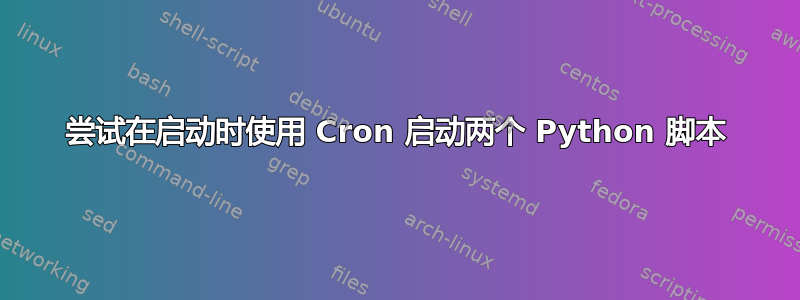
我已将以下命令放入crontab文件中:
@reboot python3 /home/pi/rpi_camera_surveillance_system.py &
@reboot python3 /home/pi/KestrelPi/PIRkestrellogger.py &
第一个脚本运行良好,但第二个脚本运行不正常。我在下面提供了两个脚本,但我也测试了第二个脚本,并且从命令行调用时它运行良好。
第一个脚本:
# Web streaming example
# Source code from the official PiCamera package
# http://picamera.readthedocs.io/en/latest/recipes2.html#web-streaming
import io
import picamera
import logging
import socketserver
from threading import Condition
from http import server
PAGE="""\
<html>
<head>
<title>Kestrel Camera</title>
</head>
<body>
<center><h1>Kestrel Cam</h1></center>
<center><img src="stream.mjpg" width="640" height="480"></center>
</body>
</html>
"""
class StreamingOutput(object):
def __init__(self):
self.frame = None
self.buffer = io.BytesIO()
self.condition = Condition()
def write(self, buf):
if buf.startswith(b'\xff\xd8'):
# New frame, copy the existing buffer's content and notify all
# clients it's available
self.buffer.truncate()
with self.condition:
self.frame = self.buffer.getvalue()
self.condition.notify_all()
self.buffer.seek(0)
return self.buffer.write(buf)
class StreamingHandler(server.BaseHTTPRequestHandler):
def do_GET(self):
if self.path == '/':
self.send_response(301)
self.send_header('Location', '/index.html')
self.end_headers()
elif self.path == '/index.html':
content = PAGE.encode('utf-8')
self.send_response(200)
self.send_header('Content-Type', 'text/html')
self.send_header('Content-Length', len(content))
self.end_headers()
self.wfile.write(content)
elif self.path == '/stream.mjpg':
self.send_response(200)
self.send_header('Age', 0)
self.send_header('Cache-Control', 'no-cache, private')
self.send_header('Pragma', 'no-cache')
self.send_header('Content-Type', 'multipart/x-mixed-replace; boundary=FRAME')
self.end_headers()
try:
while True:
with output.condition:
output.condition.wait()
frame = output.frame
self.wfile.write(b'--FRAME\r\n')
self.send_header('Content-Type', 'image/jpeg')
self.send_header('Content-Length', len(frame))
self.end_headers()
self.wfile.write(frame)
self.wfile.write(b'\r\n')
except Exception as e:
logging.warning(
'Removed streaming client %s: %s',
self.client_address, str(e))
else:
self.send_error(404)
self.end_headers()
class StreamingServer(socketserver.ThreadingMixIn, server.HTTPServer):
allow_reuse_address = True
daemon_threads = True
with picamera.PiCamera(resolution='640x480', framerate=24) as camera:
output = StreamingOutput()
#Uncomment the next line to change your Pi's Camera rotation (in degrees)
#camera.rotation = 90
camera.start_recording(output, format='mjpeg')
try:
address = ('', 8000)
server = StreamingServer(address, StreamingHandler)
server.serve_forever()
finally:
camera.stop_recording()
第二个脚本:
# Log motion in Kestrel Box every five seconds in a csv file
import RPi.GPIO as GPIO
import time
import datetime
import csv
GPIO.setwarnings(False)
GPIO.setmode(GPIO.BOARD)
GPIO.setup(11, GPIO.IN) #Read output from PIR motion sensor
GPIO.setup(3, GPIO.OUT) #LED output pin
while True:
i=GPIO.input(11)
if i==0: #When output from motion sensor is LOW
print ("No motion",i)
GPIO.output(3, 0) #Turn OFF LED
time.sleep(5)
elif i==1: #When output from motion sensor is HIGH
now = datetime.datetime.now()
GPIO.output(3, 1) #Turn ON LED
with open('bird_log.csv', 'a', newline='') as csvfile:
logwriter = csv.writer(csvfile, delimiter=',',quotechar='|', quoting=csv.QUOTE_MINIMAL)
logwriter.writerow([now.strftime("%Y")] + [now.strftime("%d")] + [now.strftime("%m")] + [now.strftime("%H")] + [now.strftime("%M")] + [now.strftime("%S")] + ["motion"])
print ([now.strftime("%Y")] + [now.strftime("%d")] + [now.strftime("%m")] + [now.strftime("%H")] + [now.strftime("%M")] + [now.strftime("%S")] + [ "motion"])
time.sleep(5)
我只是想知道如何才能让第二个脚本在启动时除了第一个脚本之外也运行。
答案1
前言:
当脚本从命令行运行,但不在 下运行时cron,原因通常是由于PATH差异,或者资源时序问题:
1.PATH不同:
你的cron工作才不是运行相同的环境作为从交互式 shell 发出的命令。printenv可以向您展示差异:
$ printenv
...
PATH=/home/pi/bin:/usr/local/sbin:/usr/local/bin:/usr/sbin:/usr/bin:/sbin:/bin: etc, etc
...
现在,编辑您的文件crontab以创建一个cron运行printenv并将输出重定向到文件的作业:
* * * * * /usr/bin/printenv > /home/pi/mycronenvironment.txt 2>&1
如果您在您的crontab如果你在你的那个不是在其 PATH 中,您可以:1) 更改 PATH,或 2) 使用命令的完整路径
2.cron不了解资源可用性
@reboot当使用该设施安排工作时,这种情况最常出现。例如,如果您的cron作业在启动时启动,并且需要网络服务。如果网络尚不可用,您的工作就会失败。既然它不是交互的,您将看不到输出(stdout和/或stderr),并且任何错误消息或警告都可能丢失。
sleep解决方案通常是在运行命令之前添加一些内容。例如:
@reboot /bin/sleep 20; /path/to/myscript >> /pi/home/myscriptlog.txt 2>&1
当cron在启动时启动并且执行此行时,cron将sleep在运行下一个命令之前持续 20 秒。这几乎总是有效,但当然是不精确因为我们可能不确定资源何时可用。如果你的工作需要,或者如果这种不确定性困扰你,你应该考虑systemd;它在启动过程中保持系统资源的可见性,并可以尽快启动您的作业。
cron另请注意:默认情况下运行的作业的错误消息/dev/null
此问题已得到纠正,如上所示:重定向和“日志文件” stderr:stdout
>> /home/pi/cronjoboutput.log 2>&1


